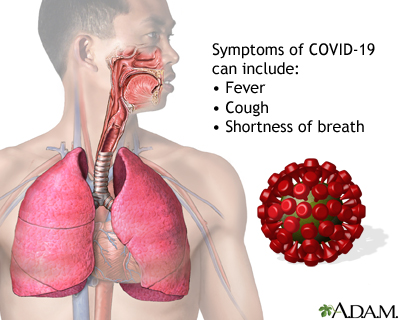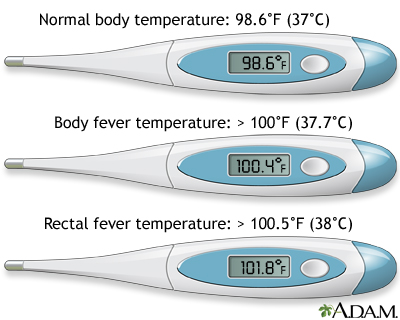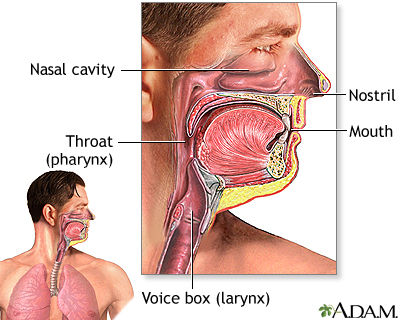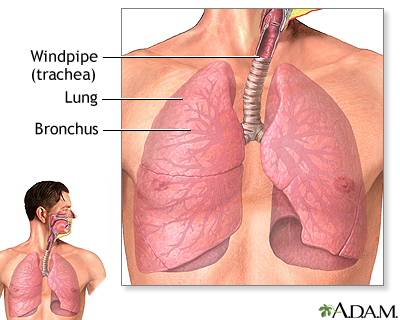COVID-19 symptoms
Coronavirus novel 2019 - symptoms; 2019 Novel coronavirus - symptoms; SARS-Co-V2 - symptoms
COVID-19 is a highly infectious respiratory illness caused by a virus called SARS-CoV-2.
COVID-19 symptoms can range from mild to severe. Symptoms may include:
- Fever
- Chills
- Cough
- Coughing up blood (hemoptysis)
- Shortness of breath or difficulty breathing
- Fatigue
- Muscle aches
- Headache
- Loss of sense of taste or smell
- Sore throat
- Stuffy or runny nose
- Nausea and vomiting
- Diarrhea
This is not a complete list of possible symptoms. Symptoms may change with new variants of the virus.
Some people may have no symptoms at all. Many have only some, but not all of the symptoms. Symptoms can also vary, depending on whether you are vaccinated.
Symptoms may develop within 2 to 14 days after you are exposed to the virus. Most often, symptoms appear around 5 days after exposure. However, you can spread the virus even when you do not have symptoms.
More severe symptoms that require seeking medical help right away include:
- Trouble breathing
- Chest pain or pressure that persists
- Confusion
- Inability to wake up
- Blue, gray, or pale skin, lips, face, or nail beds (cyanosis), depending on your skin tone
Older people and people with certain existing health conditions have a higher risk of developing severe illness and death. Health conditions that increase your risk include cancer, COPD, diabetes, heart disease and stroke, a weak immune system (immunocompromised), and many others.
Images





Animation

Considerations
Some symptoms of COVID-19 are similar to those of the common cold and the flu, so it can be hard to know for sure if you have the SARS-CoV-2 virus. But COVID-19 is not a cold, and it is not a flu.
The only way to know if you have COVID-19 is to be tested. If you want to be tested, you should contact your health care provider or use a home diagnostic test.
Most people with the illness have mild to moderate symptoms and recover fully. Whether you get tested or not, if you have symptoms of COVID-19, you should avoid contact with other people so you don't spread the illness.
Causes
COVID-19 is caused by the SARS-CoV-2 virus (severe acute respiratory syndrome coronavirus 2). Coronaviruses are a family of viruses that can affect people and animals. They can cause mild to severe respiratory illnesses.
COVID-19 spreads to people within close contact (about 6 feet or 2 meters). When someone with the illness coughs or sneezes, infectious droplets spray into the air. You can catch the illness if you breathe in or touch these particles and then touch your face, nose, mouth, or eyes.
Home Care
If you have COVID-19 or think you have it, stay at home and avoid contact with other people, both inside and outside your home, to avoid spreading the illness. You should do this right away and not wait for any COVID-19 testing.
To help treat the symptoms of COVID-19, the following tips may help.
- Rest and drink plenty of fluids.
- Acetaminophen (Tylenol) and ibuprofen (Advil, Motrin) help reduce fever. Sometimes, providers advise you to use both types of medicine. Take the recommended amount to reduce fever. Do not use ibuprofen in children 6 months or younger.
- A lukewarm bath or sponge bath may help cool a fever. Keep taking medicine -- otherwise your temperature might go back up.
- If you have a dry, tickling cough, try cough drops or hard candy.
- Use a vaporizer or take a steamy shower to increase moisture in the air and help soothe a dry throat and cough.
- Do not smoke, and stay away from secondhand smoke.
When to Contact a Medical Professional
You should contact your provider right away:
- If you have symptoms and think you may have COVID-19
- If you have COVID-19 and you are in a group for whom antiviral medicine may be given
- If you have COVID-19 and your symptoms are getting worse
Call 911 or the local emergency number if you have:
- Trouble breathing
- Chest pain or pressure that persists
- Confusion or inability to wake up
- Blue, gray, or pale skin, lips, face, or nail beds (cyanosis)
- Any other symptoms that are severe or that concern you
What to Expect at Your Office Visit
Your provider will ask about your symptoms, any recent travel, and any possible exposure to COVID-19. Your provider may take swab samples from the back of your nose and throat.
If your symptoms do not indicate a medical emergency, you can recover at home.
For more serious symptoms, you may need to go to the hospital for care.
References
Centers for Disease Control and Prevention website. COVID-19: testing for COVID-19. www.cdc.gov/covid/testing/index.html. Updated March 10, 2025. Accessed June 5, 2025.
Centers for Disease Control and Prevention website. COVID-19: types of COVID-19 treatment. www.cdc.gov/covid/treatment/index.html. Updated May 8, 2025. Accessed June 5, 2025.
Centers for Disease Control and Prevention website. Respiratory illnesses: respiratory virus guidance. www.cdc.gov/respiratory-viruses/guidance/index.html. Updated March 1, 2024. Accessed January 3, 2025.
Centers for Disease Control and Prevention website. COVID-19: symptoms of COVID-19. www.cdc.gov/covid/signs-symptoms/index.html. Updated March 10, 2025. Accessed June 5, 2025.
Del Rio C, Gandhi M, Cohen MS. COVID-19: epidemiology, clinical manifestations, diagnosis, and community prevention. In: Goldman L, Cooney KA, eds. Goldman-Cecil Medicine. 27th ed. Philadelphia, PA: Elsevier; 2024:chap 336.
BACK TO TOPReview Date: 1/1/2025
Reviewed By: Linda J. Vorvick, MD, Clinical Professor Emeritus, Department of Family Medicine, UW Medicine, School of Medicine, University of Washington, Seattle, WA. Also reviewed by David C. Dugdale, MD, Medical Director, Brenda Conaway, Editorial Director, and the A.D.A.M. Editorial team. Editorial update 06/05/2025.

Health Content Provider
06/01/2025
|
A.D.A.M., Inc. is accredited by URAC, for Health Content Provider (www.urac.org). URAC's accreditation program is an independent audit to verify that A.D.A.M. follows rigorous standards of quality and accountability. A.D.A.M. is among the first to achieve this important distinction for online health information and services. Learn more about A.D.A.M.'s editorial policy, editorial process and privacy policy. A.D.A.M. is also a founding member of Hi-Ethics. This site complied with the HONcode standard for trustworthy health information from 1995 to 2022, after which HON (Health On the Net, a not-for-profit organization that promoted transparent and reliable health information online) was discontinued. |
The information provided herein should not be used during any medical emergency or for the diagnosis or treatment of any medical condition. A licensed medical professional should be consulted for diagnosis and treatment of any and all medical conditions. Links to other sites are provided for information only -- they do not constitute endorsements of those other sites. © 1997- 2025 A.D.A.M., a business unit of Ebix, Inc. Any duplication or distribution of the information contained herein is strictly prohibited.
